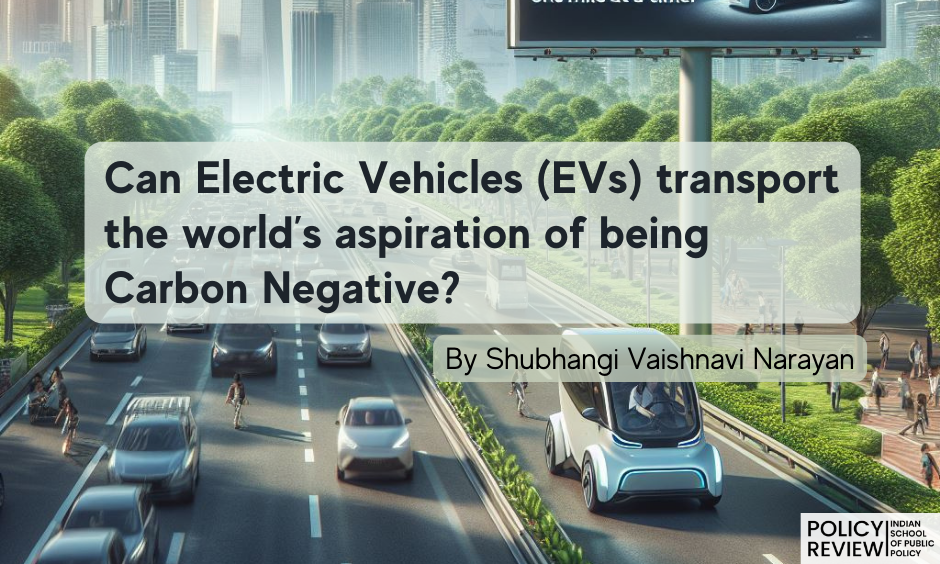
Can Electric Vehicles (EVs) transport the world’s aspiration of being Carbon Negative?

All of us have seen cars with green number plates gliding gleefully through heavy traffic. One must give credit to the fact that standing in line behind such vehicles at a traffic light does not make you cough or feel congested. This is because these run on electrically charged batteries. Since these vehicles don’t produce pollution, they are considered green and safe for our environment. However, despite the loud assertions, Battery Electric Vehicles (BEVs) are not as green as they seem. Their carbon footprint does not stem from tailpipe emissions but from their life cycle. In the subsequent paragraphs, we will see how that happens.
Firstly, the fuel that powers BEVs is grid electricity. According to data from the Ministry of Coal, up to 75% of the electricity in India is sourced from coal-based thermal power plants. The rapid electrification of automobiles will only increase the load on the existing grid, resulting in increased coal burning to fuel BEVs. Therefore, the environment friendliness of battery-powered cars depends entirely on the source of electricity used to charge them.
Further, the rechargeable batteries used in BEVs are typically Li-ion batteries. Li-ion extraction is water-intensive, primarily due to its concentration in salt flats (Vera et al., 2023). Other elements used in battery manufacturing include Nickel (Ni), Cobalt (Co), and Rare Earth Elements (REE). Elements like Nickel and Cobalt are prone to leaching and biomagnification, contaminating groundwater in the vicinity (Mukherjee et al., 2021). Groundwater, a crucial part of the water cycle, can transport Nickel and Cobalt to surface water and food supplies. These metals are hazardous to human health, and their biomagnification property compounds this threat (Tabuchi & Plumer, 2021). The production of batteries, and hence electric vehicles, is approximately 50% more water-intensive than traditional internal combustion engines.
In addition, the concentration of metals requires an energy-intensive smelting process. The heat generated in smelting facilities is commonly derived from fossil fuels, emitting sulphur and nitrogen oxides in the process. There is a reason why Rare Earth Elements (REEs) are called “rare” – their concentration in the Earth’s crust is 0.01% or less. Production of a standard 1,000-pound EV battery requires extracting and processing a staggering 500,000 pounds of earth (Mills, 2020). Thus, extracting and processing them is more tedious than other metals.
The average battery replacement rate in an EV is five years, compared to the 15-20 years of an Internal Combustion Engine’s (ICE’s) life. The demand for batteries is threefold compared to an ICE. About 15-20% of the CO2 associated with a vehicle is emitted during its manufacturing (Crawford, 2022). When considering the cumulative carbon cost, EV manufacturing is not as green as a conventional ICE vehicle, perhaps less. In a comparison between a Volvo-owned Polestar Electric and a diesel Volvo XC40, it was found that producing the electric vehicle resulted in 24 tonnes of carbon dioxide emissions, which is 70% higher than the 14 tonnes of carbon dioxide emissions generated during the manufacture of the diesel vehicles (Holloway, 2020).
Research conducted worldwide indicates that 95% of Li-ion batteries currently end up in landfills, with only 5% undergoing recycling and reuse. A viable solution could involve repurposing Li-ion batteries for stationary energy storage. Until a solution is found to recycle and repurpose used batteries, the probability of green mobility getting added to the existing e-waste disposal is very high.
The 6th Intergovernmental Panel on Climate Change (IPCC) Report mentioned that mere carbon neutrality will not keep the global temperature within 2 degrees of pre-industrial levels. The world must go carbon-negative, there is no doubt about that. In light of the above revelations, how does one move forward to achieve a carbon-negative world or even Net Zero? While EVs are attractive in terms of eliminating tailpipe emissions in metropolitan areas and improving the Air Quality Index (AQI) of some of the most polluted cities, like New Delhi, the overall cost of replacing ICE vehicles with BEVs is quite high.
The green image of Battery Electric Vehicles (BEVs) is challenged as their environmental impact extends beyond tailpipe emissions. The source of grid electricity, water-intensive battery production, and fossil fuel-dependent smelting contribute to a significant carbon footprint. Despite mitigating local air pollution, BEVs pose challenges in achieving a carbon-negative world and face issues in recycling, raising concerns about their overall environmental sustainability.
A good way forward would be to experiment with flex-fuel engines (E20-E100), and green hydrogen-powered fuel cell electric vehicles (FCEVs), and promote public transport as an alternative means of green mobility. Especially in India, where geopolitics are a real hindrance to BEV production, the focus should be on robust alternatives without causing too much damage in the process that it creates another problem instead of solving one.
References:
- Center, A. F. D. (2020). Electric Vehicle Benefits and Considerations. US Department of Energy,[Online]. Available: https://afdc. energy. gov/fuels/electricity_benefits. html.[Accessed 1 March 2023].
- Vera, M. L., Torres, W. R., Galli, C. I., Changes, A., & Flexer, V. (2023). Environmental impact of direct lithium extraction from brines. Nature Reviews Earth & Environment, 4(3), 149-165.
- Mukherjee, I., Singh, U. K., & Singh, R. P. (2021). An overview on heavy metal contamination of the water system and sustainable approach for remediation. Water Pollution and Management Practices, 255-277.
- Tabuchi, H., & Plumer, B. (2021, March 2). How Green Are Electric Vehicles? The New York Times. https://www.nytimes.com/2021/03/02/climate/electric-vehicles-environment.html
- Mills, Mark. (2020). Mines, Minerals, and “Green” Energy: A Reality Check. Manhattan Institute. Retrieved February 5, 2024, from https://manhattan.institute/article/mines-minerals-and-green-energy-a-reality-check/
- Crawford, I. (2022). How much CO2 is emitted by manufacturing batteries? | MIT Department of Mechanical Engineering. (n.d.). Retrieved February 5, 2024, from https://meche.mit.edu/news-media/how-much-co2-emitted-manufacturing-batteries
- Holloway, H. (2020, September 28). Analysis: Polestar lifts the lid on lifetime EV emissions. Autocar. Retrieved February 5, 2024, from https://www.autocar.co.uk/car-news/business/analysis-polestar-lifts-lid-lifetime-ev-emissions

Shubhangi Vaishnavi Narayan
Shubhangi is an ISPP scholar. She has a master’s in Geology from the University of Delhi. She intends to work at the interface of science and policy to contribute to India’s growth story.


